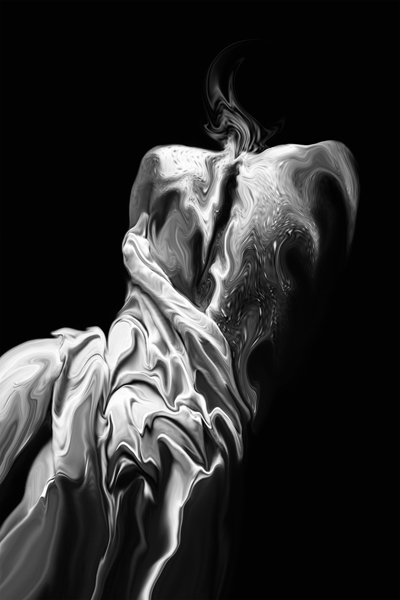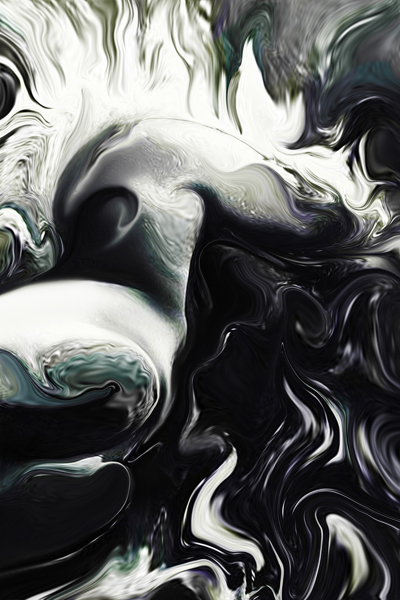Interview with Manjushree
Colette Copeland
October 2023
 Valley of Moonlight
Valley of Moonlight
I learned about the artist Manjushree from a mutual friend of ours, Lika S. Both artists graduated from Om Dayal Group of Institutions with degrees in architecture. I have met many creative people in India with architecture degrees that do not practice architecture, instead working in another creative field. I even attended a lecture in Ahmedabad given by an architect couple (IG @leewardists), who make comics about architects and architecture, especially the failings of architecture schools and the disenchantment rampant amongst many graduates. But I digress.
In 2021, a few months after graduation, Manjushree decided to join a NFT community and has been creating NFT art for the past three years. NFT art is still in its infancy, but even more so in India. Very few artists and even fewer of the general public know about NFTs or consider it an artform. Manjushree, Lika and I had an interesting conversation about the female body, grey box architecture and NFTs over a delicious lunch of Momos (Indian dumplings).
Colette Copeland: In our discussions about your radical shift from architecture school to the NFT art market, you eloquently spoke about your interest in creating fluid and organic spaces for the body to inhabit. Contradicting current design methodology of rigid, geometric, box-like structures, why not imagine spaces that integrate the body and nature in a holistic manner? When you approached your architecture professors with your innovative ideas, they were not supportive, citing practicality and costs as reasons to stay with the safe, accepted approaches to design. As I think about your interest in fluid spaces, it makes sense that the NFT virtual community fulfills some of the characteristics in your utopic vision. It is a fluid space that continues to evolve. Why NFTs? What interests you about this art process and the crypto-currency marketplace?
Manjushree: NFTs were never an intentional goal in my life. I became interested in NFTs after watching a random YouTube video related to Beeple selling his digital art as NFTs online. I was very curious to learn more about NFTs and the potential of it for the future. Also, it didn’t take much time for me to understand how it works. It felt very promising with the freedom it offered; it was truly worth it, to give it a try.
After a week or so I dropped my first collection of artworks on Opensea and started to talk about it on Twitter spaces. Many artists globally were onboarding during 2021. Everyone was so open minded, supportive and welcoming, that I became part of a great community on Twitter and this is probably why I never left the world of non-fungible digital art.
Also, NFTs offer the most transparent records between the artists and collectors, which is forever stored on blockchain and can’t get lost.
CC: The female form is the primary subject in your work. Looking at your Instagram page, the work evokes themes of shrouding–what is visible vs what is hidden, as well as desire. The work straddles the line between taking control over one’s desire as a reclamation of power, as well as also the object of desire. The digital paintings celebrate the beauty of the female form without overt sexuality. How do you navigate the viscous confines of beauty vs objectification in your work?
M: My paintings come from my huge collection of self-portrait photographs (approx. 65) which I shot over a span of 7 years. They were never meant for any other human eyes to see except mine. They were like my own treasure chest to preserve moments of self- love for my old age to remember.
After joining the NFT community, I decided to transform my photographs into paintings. These paintings are all influenced by the sculpture of The Veiled Rebecca by Giovanni Maria Benzoni. I was 8 years old when I first saw her. She is veiled from head to toe yet holds the power of attraction so vividly. Later growing up, I understood the ultimate strength which raw organic beauty possesses. Ever since I have tried to follow the similar steps. Other elements which influence my art are fluidity of water, Chinese violin music, movies and my interactions with a human being who lives in my confined world.
 On a Storm Night
On a Storm Night
My art is very intentional and direct. Every brush stroke around a specific area is targeted to bring out the unspoken emotions of sensuality and desire of flesh. I have used my brush in a way to cover the muse mostly by an illusional cloth and flowing water. The muse of my paintings wants the viewers to submit to their true thoughts without any barrier and later to learn and question more about their hidden desires and discover their true self.
The descriptions of the paintings play a key role in channeling one’s imagination into my intended direction. These short poems and passages are completely based upon the backstory of my life and its reflection in my paintings.
CC: My research centers on themes of borders and boundaries—real, imagined, physical, geographic, convergent and divergent? How does your work explore these themes? I am thinking about the relationship between the female body and gender roles in traditional India.
M: My art centers around the beauty, strength, and aesthetics, which are specific to the female body. From an Indian perspective, there are various aspects of artistic liberty running for thousands of years. My art is not a voice of protest or highlighting gender specific attributes, but more about the fluidity and inherent beauty and power of the form. It’s just a route that I follow now to focus on my body as an expression of that base medium.
CC: Within the broader contemporary art world and more specifically the contemporary NFT art market, the use of the female form would not be considered taboo. Yet, in India your work has garnered some controversy, not only for the depiction of your subject matter, but also in terms of NFTs as a legitimate art form. Please briefly explain the controversy and how you’ve handled those detractors.
M: I am not sure in which context the word taboo would be used in reference to me–art is a freedom of expression. Acceptance or otherwise could be a topic of discussion and debate. However, my work has been lauded as a bold move. I received accolades both locally and globally on my art and portrayal for an aesthetic, rather than a vulgar projection. I definitely am not objectifying the female form or otherwise interested in the defamatory or derogatory in any way. I consider myself blessed and happy to be able to do what I wish to and deliver that through my art.
CC: What are you working on now?
M: Currently I have been working on “All the World’s a Stage” by William Shakespeare. In various stages of my life, this poem has reflected its significance. How from birth till death we all human beings follow a general pattern of growth and emotions. For this artwork, I have choreographed the poses to reflect the 7 stages as directed by Shakespeare. These 7 individual photographs are then combined to create a single scene on a canvas. I’m very excited to reveal this piece in the upcoming month.
CC: That sounds compelling—a project rich with nuance and references. I am looking forward to seeing the work.
CC: For those who don’t understand crypto, please provide some insight into how the market changes regarding crypto currency and how your sales and reputation have grown, as the work became more valuable.
M: From my personal experience, the real struggle will be making yourself and your art known to the masses. Being successful here doesn’t solely depend upon the quality of your artwork. Some art collectors collect depending upon their liking for an artwork, and some collect based upon the potential of an artist in the long run. Direct interactions matter. Having a strong voice is an important factor in the NFT space as it’s growing very rapidly.
X (formerly known as Twitter), Instagram, and the personal website are very crucial in my opinion. These platforms help me in showcasing my work and my thoughts globally and meeting fellow artists and collectors in the space. Being a part of this community is importantThe value of your work will be directly proportional to how you present yourself as an artist and an active participating member in the community. With time it grows like any other business.
For more on Manjushree’s work →
This is the second in a ongoing series of interviews Colette Copeland will be doing as part of her Fulbright Research Award to India. She’ll be researching and writing about female artists who are working with non-traditional materials and processes.
Colette Copeland is a multi-media visual artist, arts educator, social activist and cultural critic/writer whose work examines issues surrounding gender, death and contemporary culture. Sourcing personal narratives and popular media, she utilizes video, photography, performance and sculptural installation to question societal roles and the pervasive influence of media, and technology on our communal enculturation.
For Colette Copeland’s interview with Pooja Bahri →
Follow Colette Copeland in India →
